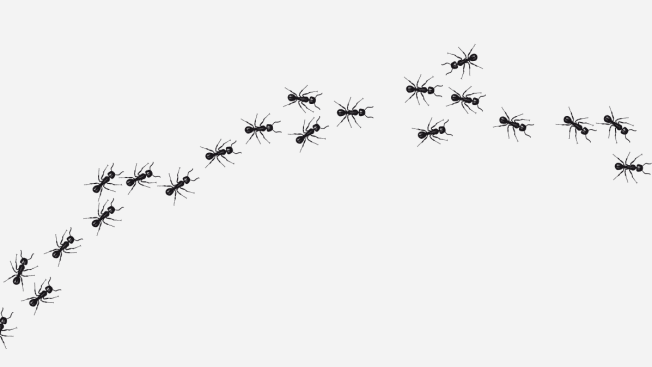How to Get Rid of Ants
These 5 simple steps will help keep them from marching into your home
When you shop through retailer links on our site, we may earn affiliate commissions. 100% of the fees we collect are used to support our nonprofit mission. Learn more.

Ants make for terrible houseguests. They come uninvited, get into everything, and are in no hurry to leave. But they’re also fairly easy to get rid of, or better still, avoid altogether.
Through the warmer months, the two types most likely to show up are house ants (technically known as odorous house ants because of the peculiar smell they release when crushed) and carpenter ants. When their natural habitat is destroyed because of development—such as construction on a new home, additions, or decks—ants seek out alternate food sources, which is what brings them indoors.

Photos: Alamy Photos: Alamy
The same can’t be said of carpenter ants, which chew through rotten or damp wood, potentially damaging windows, doors, or even structural framing in the process. Carpenter ants are about 1⁄4 to 1⁄2 inch long.
But think twice before you grab a can of bug spray and start crop-dusting your kitchen countertops.
“Ant poison may make you feel like you’re accomplishing something, but you’re not,” says CR senior scientist Michael Hansen, PhD, a biologist and ecologist who wrote his doctoral thesis on integrated pest management. “Unless you solve the problem of what’s attracting them to your house—and how they’re getting in—you should remember that there are thousands of ants in every colony, and you’ll just keep seeing them.”
With that pleasant thought in mind, we asked our pest-management experts about the best way to get rid of ants. Here are their top five tips.
1. Keep Your House Clean
Ants feed on sugar, protein, and just about anything else they can find. “Generally, a colony will send out a few ants to scout—they’ll bring back a sampling of any food they find to the colony, and hundreds will follow them back into the house,” Gangloff-Kaufmann says. “And in my experience, they particularly gravitate toward sugary liquids.”
To keep scouts from returning with their friends in tow, quickly clean up spills, particularly honey, maple syrup, and soda. And keep all food in airtight containers.
2. Eliminate Damp Spots and Rotted Wood
“While house and carpenter ants generally form a primary colony outdoors, they’ll sometimes build satellite colonies inside a home to serve as a conduit for resources,” Gangloff-Kaufmann says. “And both species prefer damp areas.” That means showers, windows, and damp spots in the basement need extra attention.
Look for leaks, fix them quickly, and replace any water-damaged materials. “Unlike termites, which eat their way through new or old wood, carpenter ants will only tunnel through wood that’s already been damaged by water,” Gangloff-Kaufmann says.
One source of water-damaged wood to avoid? A deck. These structures will rot from neglect and function like a red carpet for carpenter ants. The best way to get rid of ants there is to keep your deck in tip-top shape. Below, we’ve highlighted two decking materials that are wood alternatives, as well as a top-rated wood stain to protect a wooden deck from further damage.
3. Set Ant Baits
“The most effective method for controlling an ant infestation is using ant baits. Set them out anywhere you see ants and expect a party,” Gangloff-Kaufmann says. “If you still see ants around the house, try a few different brands of baits until you find one that’s appealing to this particular colony.”
In addition to killing off any ants that feed on the sweet, sugary bait syrup, it kills larvae when scouts track the liquid back to the colony and helps control the population.
If you have pets, check the packaging carefully and be mindful of where you place ant baits.
4. Stay Away From Sprays
You might be tempted to apply a bug barrier spray around the foundation of your home to discourage entry, but Hansen doesn’t recommend it. For starters, the spray wears off and addresses only one potential source of entry for ants. But there’s even more to his advice.
“I’d argue that insect barrier sprays are both ineffective against ants and complete overkill,” Hansen says. “Worse, some of these sprays contain chemicals that are endocrine-disrupting compounds, which can alter our hormones. Similar compounds have been linked to neurobehavioral effects in children, including reduced IQ and increased rates of ADHD, even at the low levels you’d be exposed to when spraying your house.”
Instead, the best way to get rid of ants in this case may simply be to give them a good stomp when you spot a few here and there. They may be scouts, after all, so killing them off means they can’t come back with reinforcements.
5. Make the Outdoors Appealing
Ants provide an important ecological function by aerating soil and providing a source of food for birds, according to Gangloff-Kaufmann. To keep them outdoors, consider the food sources outside the house. “Aphids, which are little insects that live on plants, excrete honeydew, a sweet substance left on plants,” she says. “Ants feed on that honeydew, but if a landscaper or homeowner sprays outdoor plants for aphids, they’re also killing off an outdoor food source for ants.”
That has the potential to drive them into your house in search of new sources of nutrients. Indoor houseplants, particularly tropical varieties, are very appealing to ants. Aphids that feed on indoor plants excrete honeydew, too, which resembles white scale on leaves. Wipe leaves clean to eliminate the food source for ants, and consider placing aphid-killing plant spikes in the soil of any houseplants.
Of course, keeping your yard in good shape and appealing to ants (as well as for yourself) is easiest with the right gear. Below, we’ve highlighted a top-rated battery lawn mower, string trimmer, and leaf blower.
The Best Way to Get Rid of Ants
Watch the video below for five expert tips on getting ants out of your house—and keeping them out.
















